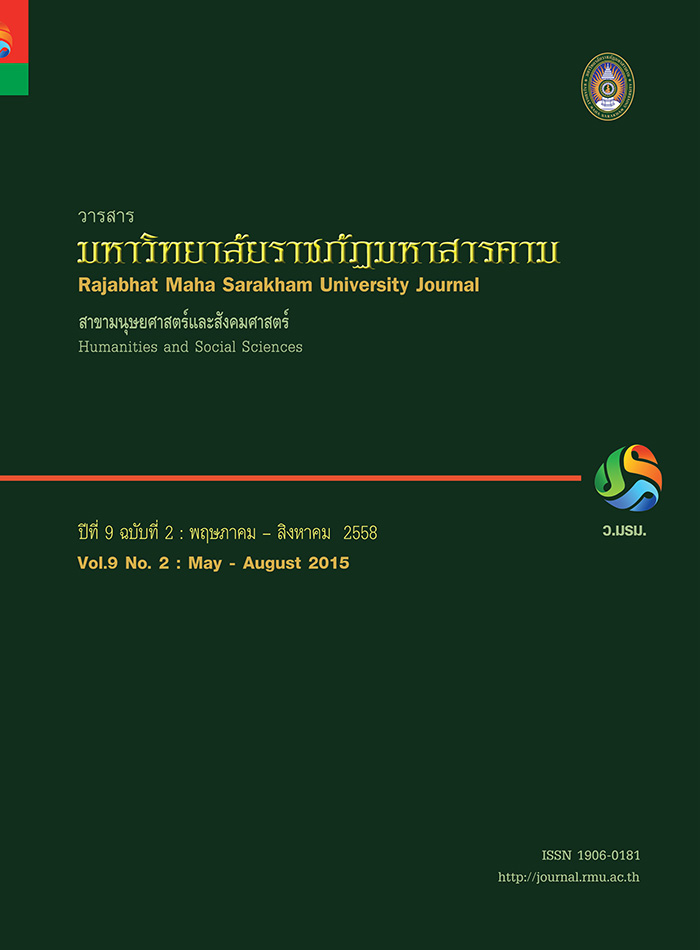การเปรียบเทียบผลการเรียนรู้ด้วยบทเรียนบนเว็บกับการเรียนแบบปกติ เรื่อง การสร้างเว็บเพจของนักเรียนชั้นมัธยมศึกษาปีที่ 5;Comparisons of Learning through Web-based Instruction and Traditional Instruction Entitled Creation of Webpage of Matthayomsuksa5Student
Main Article Content
บทคัดย่อ
การเปรียบเทียบผลการเรียนรู้เรื่องการสร้างเว็บเพจกับการเรียนแบบปกติ ของนักเรียนชั้นมัธยมศึกษาปีที่ 5 โดยมีจุดมุ่ง
หมายเพื่อ พัฒนาบทเรียนบนเว็บ เรื่อง การสร้างเว็บเพจ ชั้นมัธยมศึกษาปี ที่ 5 ที่มีประสิทธิภาพและเพื่อประเมินผลการใช้บทเรียน
ที่สร้างขึ้น กลุ่มตัวอย่างเป็นนักเรียนชั้นมัธยมศึกษาปีที่ 5/1 จำนวน 27 คน ใช้เป็นกลุ่มควบคุมที่เรียนแบบปกติ และนักเรียนชั้น
มัธยมศึกษาปีที่ 5/2 จำนวน 30 คน ใช้เป็นกลุ่มทดลองที่เรียน ด้วยบทเรียนบนเว็บ ซึ่งได้มาด้วยวิธีการเลือกแบบกลุ่ม (Cluster
Random Sampling) เครื่องมือที่ใช้ คือ 1) บทเรียนบนเว็บ เรื่อง การสร้างเว็บเพจ 2) แผนการจัดการเรียนรู้ 3) แบบทดสอบวัดผล
สัมฤทธิ์ทางการเรียน จำนวน 40 ข้อ 4) แบบทดสอบวัดความสามารถด้านความคิดสร้างสรรค์ แบบอัตนัย ประกอบด้วย 4 กิจกกรม
จำนวน 1 ฉบับ คือ ความคิดคล่อง ความคิดริเริ่ม ความคิดยืดหยุ่น และความคิดละเอียดลออ 5) แบบวัดความพึงพอใจของนักเรียน
ที่มีต่อการเรียนด้วยบทเรียนบนเว็บ จำนวน 25 ข้อ สถิติที่ใช้ในการวิเคราะห์ข้อมูล คือ ร้อยละ ค่าเฉลี่ย ส่วนเบี่ยงเบนมาตรฐาน
และสถิติที่ใช้ในการทดสอบสมมติฐาน Hotelling T2 และ Dependent Samples t-test และ F-test (One-way Repeated
Measures ANOVA) ผลการวิจัยพบว่า
บทเรียนบนเว็บเรื่อง การสร้างเว็บเพจของนักเรียนชั้นมัธยมศึกษาปีที่ 5 มีประสิทธิภาพเท่ากับ 83.33 / 81.92 และมีค่าดัชนี
ประสิทธิผลเท่ากับ 0.6780 นักเรียนมีผลสัมฤทธิ์ทางการเรียนและการคิดสร้างสรรค์หลังเรียนสูงกว่าก่อนเรียนด้วยบทเรียนบนเว็บ
เรื่อง การสร้างเว็บเพจ อย่างมีนัยสำคัญทางสถิติที่ระดับ .05 นักเรียนที่เรียนด้วยบทเรียนบนเว็บมีผลสัมฤทธิ์ทางการเรียนและการคิด
สร้างสรรค์สูงกว่านักเรียนที่เรียนแบบปกติ แตกต่างกันอย่างมีนัยสำคัญทางสถิติที่ระดับ .05 แต่นักเรียนมีคะแนนเฉลี่ยความคงทนใน
การเรียนรู้ไม่แตกต่างกัน นอกจากนี้นักเรียนมีความพึงพอใจต่อการเรียนด้วยบทเรียนบนเว็บอยู่ในระดับดีมาก
This research aimed to develop a web-based instruction entitled Creation of Webpage of Matthayomsuksa
5 students and to evaluate the implementation of the developed webpage.
The sample consisted of 57 Matthayomsuksa 5 students, obtained using the cluster random sampling
technique. They were assigned to an experimental group (class 5/1) of 30 students learned using the webbased
instruction and a control group (class 5/2) of 27 students learned using the traditional instruction.
Research instruments included (1) web-based lessons, (2) organizational plans for learning, (3) an
achievement test with 40 multiple-choice items, (4) a creative thinking test composed of 4 areas: fluency, flexibility,
originality, and elaboration, and (5) a satisfaction questionnaire about learning through the web-based lessons.
The collected data were analyzed using percentage, mean, and standard deviation. Hotelling’s T2
statistic and dependent samples t-test were employed for testing hypotheses.
The research findings revealed that the developed web-based lessons had an efficiency of 83.33/81.92
and had an effectiveness index of .6780.
The experimental group showed gains in the achievement and creative thinking tests before learning
through the developed web-based instruction at the .05 level of significance. Also, the experimental group
indicated higher results in the achievement and creative thinking tests compared to the control group at the
.05 level of significance.
Their posttest learning mean score and delayed learning mean score were not statistically different.
In addition, the evidence of satisfaction with the developed web-based lessons from the experimental group
was at the higher level.
Article Details
1. บทความที่ลงตีพิมพ์ทุกเรื่องได้รับการตรวจทางวิชาการโดยผู้ประเมินอิสระ ผู้ทรงคุณวุฒิ (Peer Review) สาขาที่เกี่ยวข้อง อย่างน้อย 3 ท่าน ในรูปแบบ Double blind review
2. ข้อคิดเห็นใด ๆ ของบทความที่ลงตีพิมพ์ในวารสารมหาวิทยาลัยราชภัฏมหาสารคาม นี้เป็นของผู้เขียน คณะผู้จัดทำวารสารไม่จำเป็นต้องเห็นด้วย
3. กองบรรณาธิการวารสารมหาวิทยาลัยราชภัฏมหาสารคาม ไม่สงวนสิทธิ์การคัดลอกแต่ให้อ้างอิงแสดงที่มา


